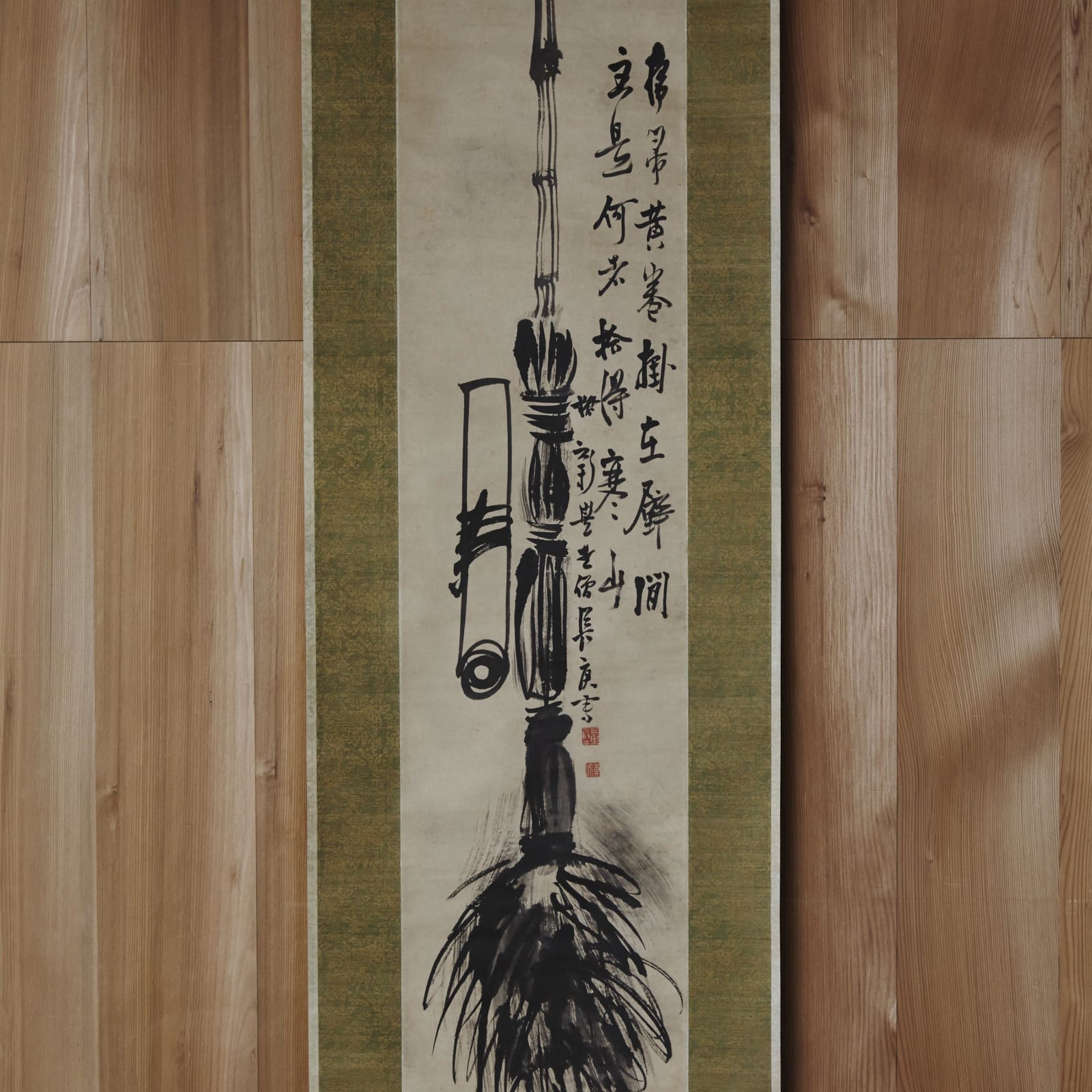Yosa Buson (1716–1783)
Hanshan and Shide
Ink on paper, hanging scroll
Inscription by the artist
Seals: Sanka koji; Tosei
121 x 26 cm
192 x 43.5 cm (overall)
Inscription by the artist
Seals: Sanka koji; Tosei
121 x 26 cm
192 x 43.5 cm (overall)
Further images
A broom and a yellow scroll, hung on the wall.
Who are the owners? Jittoku (C. Shide) and Kanzan (C. Hanshan).
The yellow scroll refers to a sutra scroll. This poem is probably composed by Buson. Despite in the form of geju, the Zen Buddhist poem, it contains no religious connotations but has a haiku-like lightness. A haiga of broom is included in the Buson Zenshu (Complete Works of Buson) vol. 6, in which a broom is associated with the “sweep of wind” in the accompanying haiku. A painting of broom with a Zen phrase is also found in the volume, in which “sweeping away worldly dusts” in the phrase is associated with the broom. These paintings do not necessarily relate to Jittoku.
Likewise, a sutra scroll alone does not automatically associate with Kanzan. When a broom and a scroll appear in pair, it comes to symbolize nothing else but Jittoku and Kanzan. Okada Rihei, a Buson specialist, writes that although there are many paintings of broom as well as broom and scroll by Buson, “many are copies.” We may study a fairly faithful copy of Buson’s painting on the subject by Yokoyama Seiki.
In Seiki’s copy, the scroll is accompanied by a poem by Kanzan, the broom by a haiku poem by Buson, which is not directly related with Jittoku. In contrast, the picture and poem are closely connected in the present picture. The five characters preceding the signature are not recognized. Buson signed with his name “Choko,” which he used in the latter half of his forties.
Yosa Buson (haiku poet, painter; 1716–1783)
Also known as Saicho; Yahantei; Shimei; Choso; Choko; Shunsei; Shain; etc.
Settsu-born haiku poet and painter in mid Edo period. Learned haiku composition under Yahantei Soa. Established his individual painting style upon studying from different schools, Chinese paintings and imported painting albums. Active together with his contemporary, Ike no Taiga.
Who are the owners? Jittoku (C. Shide) and Kanzan (C. Hanshan).
The yellow scroll refers to a sutra scroll. This poem is probably composed by Buson. Despite in the form of geju, the Zen Buddhist poem, it contains no religious connotations but has a haiku-like lightness. A haiga of broom is included in the Buson Zenshu (Complete Works of Buson) vol. 6, in which a broom is associated with the “sweep of wind” in the accompanying haiku. A painting of broom with a Zen phrase is also found in the volume, in which “sweeping away worldly dusts” in the phrase is associated with the broom. These paintings do not necessarily relate to Jittoku.
Likewise, a sutra scroll alone does not automatically associate with Kanzan. When a broom and a scroll appear in pair, it comes to symbolize nothing else but Jittoku and Kanzan. Okada Rihei, a Buson specialist, writes that although there are many paintings of broom as well as broom and scroll by Buson, “many are copies.” We may study a fairly faithful copy of Buson’s painting on the subject by Yokoyama Seiki.
In Seiki’s copy, the scroll is accompanied by a poem by Kanzan, the broom by a haiku poem by Buson, which is not directly related with Jittoku. In contrast, the picture and poem are closely connected in the present picture. The five characters preceding the signature are not recognized. Buson signed with his name “Choko,” which he used in the latter half of his forties.
Yosa Buson (haiku poet, painter; 1716–1783)
Also known as Saicho; Yahantei; Shimei; Choso; Choko; Shunsei; Shain; etc.
Settsu-born haiku poet and painter in mid Edo period. Learned haiku composition under Yahantei Soa. Established his individual painting style upon studying from different schools, Chinese paintings and imported painting albums. Active together with his contemporary, Ike no Taiga.





